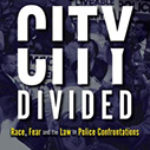Marking Time: Art In The Age Of Mass Incarceration

Author: Nicole R. Fleetwood
Publisher: Cambridge, MA: Harvard University Press, 2020. 352p.
Reviewer: Beth Adubato | August 2021
Like the artwork that graces the pages of this stunning work, Professor Nicole Fleetwood has curated a compelling and soul stirring narrative that inspires. What is striking to the reader uninformed in the tradition of prison art is not just the high quality but the incredibly clever use of available materials. Fleetwood notes for example, “]l]ike many artists in prison, [Russell] Craig engages in practices of carceral aesthetics or forms of art-making that emerge as a result of the carceral state.”
Fleetwood draws the parallel from museums to prisons. Eastern State Penitentiary, one of the first American penitentiaries, sits near the Pennsylvania Academy of Fine Arts, which was established as the first American museum in 1805. In fact, since Eastern State stopped operating as a prison, it has become a museum—visited by both art lovers and criminologists alike.
The author connects the important link between incarceration and exhibition, leading her to the discussion of how the concept of aesthetics emerged. Traditionally, our aesthetics are attached to the dominant culture—a culture that has long excluded “enslaved and exploited peoples, indigenous peoples, colonized peoples, women of all races, and the criminalized.” What Fleetwood calls “carceral aesthetics” is an artform that disavows the systems of “value/worth, criminalization, and punitive governance of dominant Western art institutions and aesthetics.” In other words, carceral aesthetics spring from a source borne of privation and isolation, stoked by the harsh realities of prison life, but that pushes aside these limitations to find the freedom that art brings, that art provides, that art reveals.
So, what are the lessons for criminal justice practitioners and criminologists? Before tackling this question, consider the criminal justice system itself. All the way back in 1932, a study known as the Wickersham Report was produced to observe our American legal system. The results showed that clearly we did not have a “system,” and what we did have was corrupt and dysfunctional. During the 1960s, the US Supreme Court found a similar situation. This is important because it is difficult to dismantle a system that is not really a system. Decades later, we lead the world in incarceration rates, and Americans must take to the streets to cry out for a more just legal system, which has never holistically functioned.
The pendulum of criminal justice philosophy swings widely and rather slowly. After the rehabilitation era came to an end in the late 1970s and early 1980s, it stayed far to the right. As this book debuts, social programs are being cut, and it would seem the pendulum may never swing back. Harkening back to Fleetwood’s connection between prisons and museums, if more people could see, could observe, this artwork that embodies humanity—that so often makes a plea to consider the depth of character masked by a prison uniform and a number—perhaps we could remember those forgotten people who are behind thick walls? Would these practitioners of justice, those who espouse steep mandatory minimums while simultaneously cutting funding for art programs in schools and certainly prisons, would these same people feel differently if they saw? Would they put down the gavel and gaze at the self-portraits on mixed media? Would they reconsider consecutive sentences for young people if they could see James “Yaya” Hough’s acrylic on parachute cloth that evokes African art while stating, “I was lost. Art broke all my chains?” Would they be stunned by Moliere Dimanche Jr.’s complicated and disturbing graphite drawings on the back of prison papers, and see their way to distinguish between rehabilitating and warehousing?
While the lesson of this book is abundantly clear—there is a wealth of creativity that is untapped, and programs in prisons that allow this to be released would most likely lead to less prison disruption and a decrease in recidivism—the ramifications are much more layered. The systemic inequality in our so-called criminal justice system must be eradicated, that is true. Poverty, racism, sexism, and other societal ills have brought us to lead the world in prisoners. But solely from a prison perspective, can this book lead practitioners to acknowledge the need to allow prisoners to develop their talents? Since the late 1970s, college courses for inmates—and importantly, Pell Grants with which to pay for them–have been curtailed during the climate of “lock ‘em up and throw away the key,” but most recently, social leaders and academics have taken up that cause. What sets the soul free? The expansion of the soul through art, through education, through intellectual exploration. Although people may be locked up, we do not also have to lock away their spirits.
There is an irony to this work that cannot be overlooked—many of these artists either discovered their talents or certainly developed their talents because of their prison stays.
If there is any conundrum about the book, it is the title—unless Fleetwood is simply winking at us. Obviously, the term “marking time” evokes the ennui of the sameness and the hopelessness of imprisonment. The consequences of this boredom and lack of freedom would be something you would do to “mark time,” such as doodling. Time is not being marked, it is being celebrated. Perhaps by winking at us, she is directing us to her eyes, to our eyes, to a vision of what we do not normally observe?
This book does not speak so much to the problems that underlie mass incarceration, but it does show us how people can rise from incapacitation to exhilaration through artistic expression. It is less a book about mass incarceration itself, and more a statement about the massive strength of the human spirit.
Beth Adubato, Ph.D., Associate Professor of Criminal Justice, Saint Peter’s University


